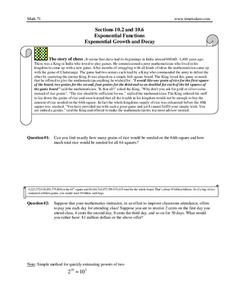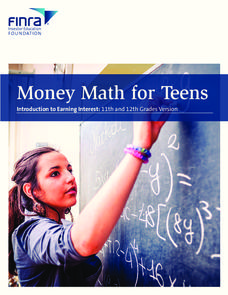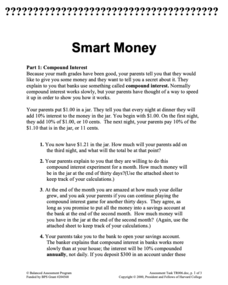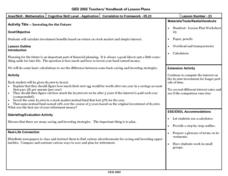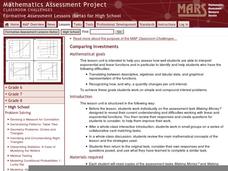West Contra Costa Unified School District
Interest and the Number e
Mary, Mary, quite continuously, how does your money grow? Uses examples to examine the difference between simple interest and compound interest, and to take a look at different rates of compounding. Learners explore what would happen as...
Houghton Mifflin Harcourt
Simple and Compound Interest
Your learners will get lots of practice calculating simple and compound interest by the end of this lesson. Simple explanations and examples lead learners through the concepts and steps of calculating simple and compound interest...
Curated OER
Simple and Compound Interest
In this simple and compound interest worksheet, learners find the ending balance to simple interest problems. They determine the total value of investments compounded over a period of years. This four-page worksheet contains 20 interest...
EngageNY
Why Do Banks Pay YOU to Provide Their Services?
How does a bank make money? That is the question at the based of a instructional activity that explores the methods banks use to calculate interest. Groups compare the linear simple interest pattern with the exponential compound interest...
West Contra Costa Unified School District
Interest and the Number “e”
Make a connection between different types of interest and how they are calculated! This algebra II lesson progresses from simple interest to compound interest to continually compounded interest. Formulas are developed rather than given,...
Curated OER
M & M Interesting
Students compute and collect interest payments in the form of M&M candies. In this mathematics instructional activity, students work in small groups to compute either simple or compound interest. They compare the growth of their...
Curated OER
M&M Interesting
Students examine the concepts of trade-offs and opportunity cost to decide between savings accounts with simple interest and those with compound interest. They calculate interest earned on account balances while working in groups and...
Curated OER
Time Value of Money- Compound Interest
Pupils study the concept of compound interest as it relates to the time value of money.
SaveandInvest.org
Introduction to Earning Interest: Middle School
Does your bank pay you for allowing them to hold your money? Class members research three different ways they can earn money using money already in the bank. Topics include certificates of deposit, statement savings accounts, and money...
Curated OER
Compound Interest
Young scholars solve compound interest problems. In this solving compound interest problems instructional activity, students use TVM Solver on the Ti-83 Plus. Young scholars find the future value of a principal amount at a given interest...
Curated OER
Compound Interest
In this consumer math worksheet, students read an example of how to use the interest formula to compute interest that is compounded daily over six years. They complete a chart where they compute the interest earned over 10 years when the...
Mt. San Antonio Collage
Exponential Growth and Decay
Start with the basics and move up the exponential ladder to master a variety of problem-solving and application problems. The problems are heavy on exponential growth and decay, compound interest, and natural log.
SaveandInvest.org
Introduction to Earning Interest: Grades 9-10
Does your bank pay you for allowing them to hold your money? The lesson covers three different ways your money can make money. Topics include certificates of deposit, statement savings accounts, and money market accounts.
SaveandInvest.org
Introduction to Earning Interest: Grades 11-12
Does your bank pay you for allowing them to hold your money? Class members investigate three different ways money can make more money. Topics include certificates of deposit, statement savings accounts, and money market accounts. This...
Curated OER
Introduction to Earning Interest: What are APR and APY?
Pupils explore saving and investing money. In this middle school personal finance lesson, students define and use investment vocabulary, explore compound interest and its effect of savings, and compute simple and compound interest. ...
Curated OER
Interesting Interest Rates
Your young bankers compare earning interest accumulated yearly and monthly to decide which method most increases their balance. Using an exponential function to model the bank balance affords the learners more practice connecting these...
Curated OER
The Business of Interest
Students explore the concept of simple and compound interest. In this interest lesson plan, students discuss how interest works on a loan. Students calculate simple and compound interest on loans of fictitious characters from a video.
Concord Consortium
Smart Money
Watch the money grow daily. Scholars tackle a problem to determine how much money they will have if a dollar grows at 10 percent compounded daily after a month. Using that knowledge, learners notice the difference between varying savings...
Curated OER
Investing for the Future
Twelfth graders perform basic calculations for saving and investment strategies. they simulate the investment of $1,000 in the stock market and savings account. they determine which pays the greater dividend.
Curated OER
Worksheet #6, Exponents, Interest, and Radioactive Decay of Isotopes
In this calculus worksheet, students sketch graphs of given exponential functions. They compute the principal needed to have a given ending balance when the interest is compounded at varying times. Students use a simple exponential model...
Curated OER
Data Analysis: Investing is an "Interesting" Experience
Students compute interest earned. In this data analysis lesson, students examine investments and interest rates. They compute the total interest earned and find the simple interest.
Curated OER
Solving Problems Using Interest
In this math worksheet, students look for the solutions to the problems using interest. Then they calculate the new principal after adding the interest.
Curated OER
Algebra Word Problems
In this inequality word problem instructional activity, students solve ten word problems related to algebra and inequalities. They first determine how many pounds of cheese it would take to make a specific amount of grated cheese...
Curated OER
Comparing Investments
Money, money, money. A complete activity that makes use of different representations of simple and compound interest, including written scenarios, tables, graphs, and equations to highlight similarities and differences between linear and...













